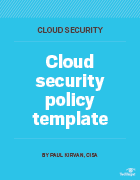How to create a cloud security policy, step by step
What are the necessary components of a cloud security policy, and why should an organization go to the trouble to create one? Download a template to get the process started.
Effective cloud security means more than implementing strong access and authentication controls or encrypting data at rest and in transit. What's needed is a set of rules for how cloud security is managed, and the key to that is a cloud security policy.
A cloud security policy contains detailed guidelines to help an organization ensure that it operates safely in the cloud. Because cloud resources can be used in multiple configurations of private, public and hybrid cloud, each of these arrangements must be accounted for when considering a security policy.
Let's look at what it takes to prepare a cloud security policy to address data breaches and security incidents. Also included here is a ready-to-use template to help prepare a basic cloud security policy.
Why is a cloud security policy important?
Most IT department policies and procedures complement each other. They define what is to be provided -- e.g., a cloud security policy -- and how policy compliance is achieved -- e.g., cloud security procedures, assessments and testing.
This article is part of
What is cloud security management? Guide and best practices
Without policies, companies could be at risk of security breaches, financial losses and other security consequences. Absence of relevant policies can be cited during IT audit activities and, in some cases, might result in noncompliance fines or other penalties.
Cloud security standards must also be examined for compliance requirements. One particular standard is ISO 27001:2022 Information security, cybersecurity and privacy protection -- Information security management systems -- Requirements. This global standard has specific requirements for compliance, and organizations can qualify for certification of compliance. Two important domestic cloud security standards include the following:
- NIST SP 800-53 Rev. 5 (2020), Security and Privacy Controls for Information Systems and Organizations. This is an important security standard and it applies to cloud services.
- NIST SP 800-144 (2011), Guidelines on Security and Privacy in Public Cloud Computing. This standard provides guidance on implementing public cloud security, including security measures, protecting user accounts, use of strong passwords and other authentication methods.
In addition, customers might want assurances that their data will be protected from malware and other cyberattacks. Making the cloud security policy -- or an abbreviated version with key elements highlighted -- available for customer review can often alleviate fears of data damage or theft and improve brand reputation.
Cloud security policies are often written around topics such as the following:
- Cloud security controls.
- Security management tools.
- Acceptable employee cloud use.
- Data allowed in the cloud.
- Data protection in the cloud.
- Incident response procedures.
- Cloud access control.
- Cloud compliance standards.
Steps to create a cloud security policy
To begin, six cost-effective options are available for creating a cloud security policy:
- Adapt existing information security policies to cloud. These can use the existing policy structure and incorporate relevant components that address cloud security.
- Add cloud elements into an existing cybersecurity policy.
- Find examples of policies and adapt them to your organization's needs.
- Evaluate and select software from vendors that can produce policies quickly.
- Review cloud security standards for frameworks and content that can be built into the policy.
- Use the cloud security policy template included in this article.
When preparing a cloud security policy, ensure the following steps are adhered to, at a minimum:
- Identify the business purpose for having cloud security and, therefore, a cloud security policy and associated procedures.
- Secure senior management's approval to develop the policy.
- Establish a project plan to develop and approve the policy.
- Convene a team to develop the draft policy.
- Ask the cloud vendor(s) to assist with policy development.
- Schedule management briefings during the writing to ensure relevant issues are addressed.
- If the cloud vendor(s) is part of the policy development team, ensure they are invited to meetings
- Invite legal and HR teams to review and comment.
- Invite internal audit and/or IT audit teams to review.
- Invite risk management department to review.
- Distribute the draft for final review (include the cloud vendor) for comments prior to submitting it for management approval.
- Secure management approval, then disseminate the policy to employees.
- Arrange security-awareness training sessions for employees.
- Establish a review and change process for the policy using change management procedures.
- Schedule and prepare for annual audits of the policy.
Components of a cloud security policy
Policies for cloud security can be simple. A few paragraphs might suffice to describe relevant cloud activities without going into a lot of specifics. More details can and should be included as needed, but most IT departments will want to keep policies concise while still addressing the important issues.
The following is an outline of the necessary components of a cloud security policy:
- Introduction. State the fundamental reasons for having a cloud security policy.
- Purpose and scope. Provide details on the cloud policy's purpose and scope.
- Statement of policy. State the cloud security policy in clear terms, including systems that might be affected, the cloud vendor(s) involved, standards that address cloud security and any other relevant data.
- Policy leadership. State who is responsible for approving and implementing the policy.
- Verification of policy compliance. State what is needed, such as assessments, exercises or penetration tests, to verify cloud security activities comply with policies. If a service-level agreement (SLA) is in place, it should be noted in the policy.
- Penalties for noncompliance. Define penalties -- for example, verbal reprimand and a note in the personnel file for internal incidents or fines and legal action for external activities -- for failure to comply with policies and SLAs if they are part of the policy.
- Appendices (as needed). Provide additional reference information, such as lists of contacts, standards and frameworks, SLAs or additional details on specific cloud security policy statements.
Things to remember
Once a cloud security policy has been approved and put into effect, think of it as a living document -- not a static one. Use the policy to help establish key performance indicators for security, plan for future audits, ensure compliance and establish a culture where security is emphasized. In addition, be sure the policy includes requirements for regular testing of cloud security services, using tools, penetration tests and breach-attack simulations.
Paul Kirvan is an independent consultant, IT auditor, technical writer, editor and educator. He has more than 25 years of experience in business continuity, disaster recovery, security, enterprise risk management, telecom and IT auditing.







